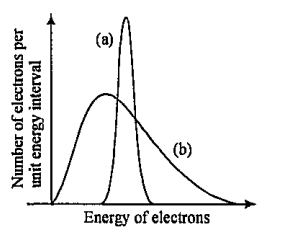A radioactive decay can form an isotope of the original nucleus with the emission of particles
one α and four β
one α and two β
one α and one β
four α and one β
The correct Answer is:B
Emission of α− particle decreases the atomic number and the mass number by 2 and 4 respectively. Emission of β− particle increases the atomic number by 1 while the mass number remains unchanged. Therefore, after the emission of one α and two β− particles, the atomic number remains the same while the mass number decreases by 4. Hence, the emitted nucleus is the isotope of hte original nucleus.
Topper's Solved these Questions
- ATOMS AND NUCLEIBOOK - MTG GUIDECHAPTER - ATOMS AND NUCLEIEXERCISE - NEET CAFÉ (TOPICWISE PRACTICE QUESTIONS)(NUCLEAR REACTION)
6 Videos
- ATOMS AND NUCLEIBOOK - MTG GUIDECHAPTER - ATOMS AND NUCLEIEXERCISE - NEET CAFÉ (TOPICWISE PRACTICE QUESTIONS)(NUCLEAR FISSION AND FUSION)
9 Videos
- ATOMS AND NUCLEIBOOK - MTG GUIDECHAPTER - ATOMS AND NUCLEIEXERCISE - NEET CAFÉ (TOPICWISE PRACTICE QUESTIONS)(NUCLEAR FORCE)
2 Videos
- CURRENT ELECTRICITY BOOK - MTG GUIDECHAPTER - CURRENT ELECTRICITY EXERCISE - MCQs AIPMT / NEET
32 Videos
Similar Questions
Originally the radioactive beta decay was thought as a decay of a nucleus with the emission of electrons only (Case I). However, in addition to the electron, another (nearly) massless and electrically neutral particle is also emitted (Case II). Based on the figure below, which of the following is correct:

View SolutionWhich one of the following combinations of radioactive decay results in the formation of an isotope of original nucleus ?
View Solution
Knowledge Check
In a radioactive decay, a nucleus is transformed into another with the emission of a positron. In this process the neutron-proton ratio
AdecreasesBremains sameCincreasesDbecomes oneWhich one of the following combinations of radioactive decay results in the formation of an isotope of the original nucleus?
AOne alpha and four betaBOne alpha and two betaCOne alpha and one betaDTwo alpha and one betaWhat kind of radioactive decay does not lead to the formation of a daughter nucleus that is an isobar of the parent nucleus
Aα−raysBβ−raysCPositronDElectron capture
U238 decays into Th234 by the emission of an a-particle. There follows a chain of further radioactive decays, either by α-decay or by β−decay. Eventually a stable nuclide is reached and after that, no further radioactive decay is possible. which of the following stable nuclides is the end product of the U238 radioactive decay chain ?
View SolutionIn a radioactive decay chain, the initial nucleus is 23290.Th. At the end there are 6 α-particles and 4 β-particles which are emitted. If the end nucleus is AZ.X,A and Z are given by :
View SolutionIn a radioactive decay chain, the initial nucleus is 23290.Th. At the end there are 6 α-particles and 4 β-particles which are emitted. If the end nucleus is AZ.X,A and Z are given by :
View SolutionHeavy radioactive nucleus decay through α−decay also. Consider a radioactive nucleus x. It spontaneously undergoes decay at rest resulting in the formation of a daughter nucleus y and the emission of an α− particle. The radioactive reaction can be given by
x→y+α
However , the nucleus y and the α− particle will be in motion. Then a natural question arises that what provides kinetic energy to the radioactive products. In fact, the difference of masses of the decaying nucleus and the decay products provides for the energy that is shared by the daughter nucleus and the α− particle as kinetic energy . We know that Einstein's mass-energy equivalence relation E=mc2. Let mx,my and mα be the masses of the parent nucleus x, the daughter nucleus y and α− particle respectively. Also the kinetic energy of α− particle just after the decay is E0. Assuming all motion of to be non-relativistic.
Which of the following is correct ?
View SolutionA nucleus with an excess of neutrons may decay with the emission of
View Solution
